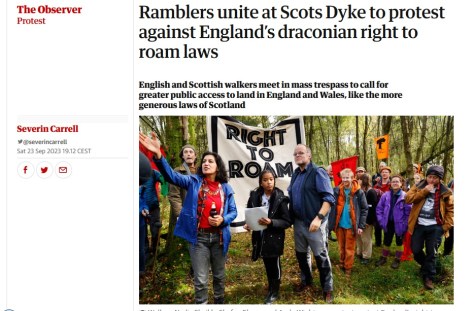Great Lives: Ken Loach on Gerrard Winstanley – BBCR4 – 26 Sep 2023
But sadly not a lot on Pride’s Purge, or the injustice and horrors of Charles’ execution, which drove Winstanley to act, and cleared a way for the mercantile classes’ British Empire…
https://www.bbc.co.uk/sounds/play/m001qtc5
 Veteran British film director Ken Loach nominates the 17th century radical pamphleteer and and leader of the Diggers, Gerrard Winstanley.
Veteran British film director Ken Loach nominates the 17th century radical pamphleteer and and leader of the Diggers, Gerrard Winstanley.
Born in Wigan in 1609, Winstanley began writing religious pamphlets after his cloth selling business in London went bankrupt and he was forced to move to the country. There his ‘heart was filled with sweet thoughts … that the earth shall be made a common treasury of livelihood to all mankind’, for ‘the great Creator Reason, made the Earth to be a Common Treasury… for Man had Domination given to him, over the Beasts, Birds and Fishes; but not one word was spoken in the beginning, that one branch of mankind should rule over another.”
Winstanley began to dig a nearby wasteland, calling on others – rich and poor -to join him in the digging, which he believed would start a revolution and feed the poor. His ideas were radical, communal, spiritual and deeply challenging. Within a year the Diggers had been aggressively expelled from their site of occupation.
The late Tony Benn called the Diggers, ‘the first true socialists’, but Winstanley has also been claimed by anarchists and environmentalists.
With Emeritus Professor of Early Modern history, Ann Hughes. Presented by Matthew Parris and produced for BBC Audio in Bristol by Ellie Richold
The Land Is Ours’ 1999 occupation of St George’s Hill
Winstanley (1975) dir. Kevin Brownlow
WATCH HERE ON ARCHIVE.ORG
 Or buy via the BFI – Winstanley – A powerful story of the 1649 St George’s Hill commune inspired by the visionary leadership of Gerrard Winstanley. 1649. With poverty and unrest sweeping England, a group of impoverished men and women, known as the diggers, form a settlement on St George’s Hill, Surrey. Inspired by the visionary leadership of Gerrard Winstanley, the commune’s tireless, yet peaceful attempts to assert their right to cultivate and share the wealth of the common land, are met with crushing hostility from local landowners and government troops. With Winstanley, filmmakers Brownlow and Mollo (the creators of It happened Here) have produced an astonishingly authentic historical film, and a powerful, moving story of one extraordinary man’s vision. Special features New restoration by the BFI National Archive. New filmed interview with Kevin Brownlow and Andrew Mollo (38 minutes) It happened Here Again (Eric Mival, 1976, 48 minutes) the making of Winstanley 9 Dalmuir West (Kevin Brownlow, 1962, 12 minutes) Fully Illustrated 32-page booklet with contributions by Marina Lewycka (author of A Short History of tractors in Ukrainian), Eric Mival, Jonathan Rosenbaum, Tom Milne, and David Robinson; plus biographies and credits. Dolby Digital 2.0 (320kbps)
Or buy via the BFI – Winstanley – A powerful story of the 1649 St George’s Hill commune inspired by the visionary leadership of Gerrard Winstanley. 1649. With poverty and unrest sweeping England, a group of impoverished men and women, known as the diggers, form a settlement on St George’s Hill, Surrey. Inspired by the visionary leadership of Gerrard Winstanley, the commune’s tireless, yet peaceful attempts to assert their right to cultivate and share the wealth of the common land, are met with crushing hostility from local landowners and government troops. With Winstanley, filmmakers Brownlow and Mollo (the creators of It happened Here) have produced an astonishingly authentic historical film, and a powerful, moving story of one extraordinary man’s vision. Special features New restoration by the BFI National Archive. New filmed interview with Kevin Brownlow and Andrew Mollo (38 minutes) It happened Here Again (Eric Mival, 1976, 48 minutes) the making of Winstanley 9 Dalmuir West (Kevin Brownlow, 1962, 12 minutes) Fully Illustrated 32-page booklet with contributions by Marina Lewycka (author of A Short History of tractors in Ukrainian), Eric Mival, Jonathan Rosenbaum, Tom Milne, and David Robinson; plus biographies and credits. Dolby Digital 2.0 (320kbps)
Winstanley is a 1975 British black-and-white film made by Kevin Brownlow and Andrew Mollo and based on the 1961 David Caute novel Comrade Jacob.
The film details the story of the 17th-century social reformer and writer Gerrard Winstanley, who, along with a small band of followers known as the Diggers, tried to establish a self-sufficient farming community on common land at St George’s Hill (now a private gated estate, the ‘Beverly Hills’ of Britain) near Cobham, Surrey.
The community was one of the world’s first small-scale experiments in socialism or communism, and its ideas were copied elsewhere in England during the time of the Protectorate of Oliver Cromwell, but it was quickly suppressed, and in the end left only a legacy of pamphlets and ideas to inspire later generations of socialist theorists.



